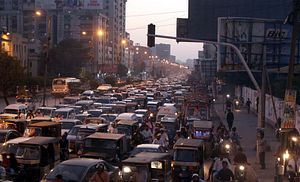Despite the optimistic buzz surrounding the China-Pakistan Economic Corridor (CPEC), Pakistan is experiencing an acute energy crisis. Karachi plunged into darkness twice last week due to failures at multiple sites run by K-Electric, Pakistan’s only private electricity provider. The blackouts came just two weeks after a heatwave, compounded by power outages, claimed the lives of more than 1,000 people.
Faulty units at Bin Qasim power plant caused the first blackout at around 9:00 p.m. on Tuesday night, affecting more than half of the city. On Wednesday, a transformer tripped, causing 12 of 64 grid stations to stall and plunging Karachi back into darkness. Consequently, the blackouts shut down the city’s main pumping stations at Dhabeji, Gharo, Pipri, Hub, and Northeast Karachi, causing a daily deficit of 525 million gallons, according to The Express Tribune. Karachi Water and Sewage Board estimated it would take four days to restore water supply to normal capacity as the system was empty and is supplied from Kalri Lake, an 18-hour journey to the sweltering city.
The blackouts once again occurred at a dangerous time for Pakistan’s majority Muslim community, which is still observing the holy month of Ramadan. Fortunately, Karachi has experienced a respite from last month’s deadly heatwave; otherwise, the city may have faced another high death toll.
K-Electric, which was privatized in 2005, has repeatedly come under scrutiny for its often illegal profit-maximizing business practices and countless mishaps leading to prolonged blackouts and frequent load shedding. In 2014, the National Electric Power Regulatory Authority found several K-Electric executives responsible for systematically overbilling consumers. Water and Power Minister Khawaja Mohammad Asif has repeatedly accused K-Electric of intentionally producing electricity below its full capabilities to legitimize the usage of 650MW of power allocated to the company by the government. The Tehrik-i-Taliban Pakistan even publicly warned K-Electric in June to end load shedding or face violent action.
The government quickly shifted all of the blame for Karachi’s energy woes onto K-Electric, an easy target with an abysmal reputation among consumers. However, Karachi’s energy crisis does not solely stem from an inept local electricity provider; the causes trickle down from all facets of the government to the marginalized residents living on encroached land illegally siphoning electricity.
Underinvestment and inadequate diversification of the nation’s energy sector coupled with rampant insecurity have made it extremely difficult to keep up with steadily increasing energy demand. Rapid urbanization and poor city governance led to the establishment of unplanned housing developments, where most electricity theft occurs. Politicians have routinely failed to crack down on K-Electric in any meaningful way, despite reportedly owing federal government entities Rs130 billion, or $1.27 billion, in subsidies because the government set power tariffs far below supply costs.
Although Pakistan has made great strides recently, and the deal signed with China promises $46 billion in energy and infrastructure development, there is no quick fix for the crisis. The country needs to come to terms with the fact that the CPEC may fall flat, just as many other comparable infrastructure projects have done. Even if it is a booming success, it will be years if not a decade before supply catches up with demand. As such, any possible steps need to be taken now to prevent the energy crisis from competing to be the country’s leading source of insecurity. The government can start by renegotiating its contract with K-Electric, which reached expiry more than six months ago.
The contract signed by K-Electric and the government in 2009 expired at the end of January and is a major contributor to the energy crisis. The previous contract allocated K-Electric 650MW of available electricity from the national grid at marginal costs, allowing K-Electric to use the grid if demand exceeds its capacity. Since drawing from the national grid costs less than producing the same MW at its facilities, K-Electric is incentivized to underproduce, forcing the government to incur the costs. To force K-Electric to be self-sufficient, lawmakers have proposed reallocating the 650MW to Punjab, which already relies almost entirely on the national grid. However, the benefit to Punjab and the response from K-Electric still may not outweigh the consequences of taking the 650MW away from Karachi. If the government agrees to continue allocating the 650MW, they could increase the cost significantly, but K-Electric allegedly already owes a massive debt to the government. Clearly, renegotiating the contract will be no easy task. The terms will almost certainly have broad implications for the future of Pakistan as power shortages in the country’s economic hub take a massive toll on the nation’s GDP.
If Pakistan hopes to harness the benefits of the CEPC, the country must first address the plight of its largest city by reining in K-Electric and improving its capacity to govern.
Brian M. Perkins is a South and Central Asia Analyst for a political risk consultancy and a freelance journalist specializing in militancy, terrorism, and international development.

































